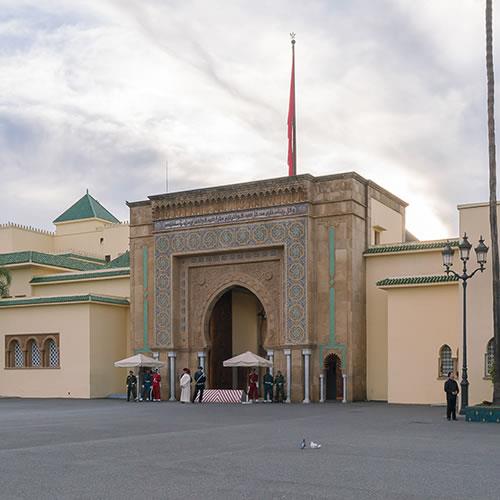Day 1 in Meknes
Welcome to Morocco! Upon arrival in Morocco, you will go through customs and immigration. Should you opt to purchase a transfer to your hotel, a representative will be waiting for you as you exit immigration. If you are visiting another city first and decide to purchase a transfer, a representative will be waiting for you at your hotel on the day you need to go to Meknes. Arrive at your hotel, check in and do not give in to jet lag! There is so much for you to see and do!
Start by heading to the city`s largest square, Lahdim Square. It is located right in the middle of the UNESCO World Heritage-certified ancient Medina. Within 1,000 feet of the square, you will find a number of sights you can explore. Let`s start with the square; off the square you can find the Dar Jamai Museum, with its impressive collection of zellige mosaic tilework, and the Marché Couvert (covered market). You can shop for souvenirs and get something to eat at the market or at various stalls, restaurants or cafés on the square. Heading east from the square on Rue Dar Smen, you will see the Meknes Museum on the right; here you can learn about the colorful history of this former imperial capital of Morocco. Across from the Museum, the road on the other side of the street leading north is called Rue Dar Aïssi, which leads you to the Great Mosque of Meknes. Non-Muslims will only be able to stroll the courtyard, but they will be able to tour the Bou Inania Madrasa directly opposite the Great Mosque. The madrasa was built in the 14th century in the Marinid architectural style and is one of the few religious buildings in Morocco open to non-Muslim visitors. If you still have time before sunset, spend the last few moments of the day at Place Lalla Aouda, which dates from the time of Moulay Ismail, the leader who made Meknes the capital of his sultanate. Return to your accommodations at the end of the day.


Day 2 in Meknes
Begin the morning at one of the largest, most ornate, and most beautiful city gates in Morocco, the Bab Mansour. Take some pictures to show people how much beautiful Meknes is! Afterwards, head to the other side of the roundabout to a mysterious and storied landmark, Kara Prison. This underground dungeon is where Sultan Moulay Ismail kept over 40,000 criminals, ranging from thieves to traitors. Nearby is one of Meknes`s largest tourist attractions, the Mausoleum of Moulay Ismail, which contains the body of the former Sultan, but since 2016 it has been closed for extensive renovations. Travel along the walled Avenue Bab Marrah for a half-mile until you reach the Royal Palace (Dar El-Mahkzen) on the right-hand side. Visit the grand main gate where you can take a selfie (but not too close to the King`s guards).
Avenue Bab Marrah leads visitors to the Royal Stables and the Imperial Granary. During the time of Moulay Ismail, taxes were paid in grain, and the grain was used to feed Moulay Ismail`s massive stable of horses. In fact, over 12,000 horses once lived at the Royal Stables. The ruins of both structures are available for visitors to see and explore. Right next to the stables and granary, there is a large reservoir, the Agdal Basin (sometimes called the Granary Basin). The reservoir`s water was used for Moulay Ismail`s gardens and granary, and to this day is also used as a venue for boating and pleasure cruises.
Travel three-quarters of a mile on the road that runs parallel to the western side of the Royal Stables and the Agdal Basin until you reach Borj Belkari, one of the first city gates built by Moulay Ismail in the late 17th century. Today the interior houses the Meknes Pottery Museum. Cross Boulevard Mohammed VI and walk down Avenue Ibn Zaidoun. To the left, you will see the buildings of the Nouveau Mellah, the new Jewish quarter, consisting of the small Jewish community who stayed in Meknes after the mass exodus of Jews following the creation of Israel as a nation-state in 1948. Once you pass the cross street Rue de Palestine, you will see the Talmud Torah building on the left, which is the hub of Jewish religious life and education in Meknes, and on the right, in the Ancien Mellah (old Jewish quarter), you will see the Jewish Cemetery, the final resting spot for members of the Meknes`s Jewish community dating back 600 years. Return to the Medina and Lahdim Square to eat dinner and stroll the streets in search of souvenir finds. Return to your accommodations at the end of the day.



Additional Days in Meknes
If you have more time to explore the area, consider spending a day at the ruins of the Berber/Roman city of Volubilis. Located about 20 miles due north of Meknes, Volubilis is a UNESCO World Heritage Site. Volubilis was first built in the third century before the Common Era as the capital of the Berber kingdom of Mauretania. Then, for three centuries, Romans occupied the city and expanded it further. Finally, it was the capital of the Emirate of Morocco for three centuries, and to think, all of this occurred before 1100 CE! Large portions of the ruins still exist, as they were intact until just a couple of centuries ago. If you can get away from the city to explore one of the Roman Empire`s southwesternmost cities, take the opportunity. You won`t regret the trip!

Your Last Day in Meknes
Depart your hotel and head to the airport for your return home. If you are purchasing a private transfer, a representative will meet you at the hotel in time to take you to the airport for your flight out. We hope you enjoyed the sights of Meknes!
